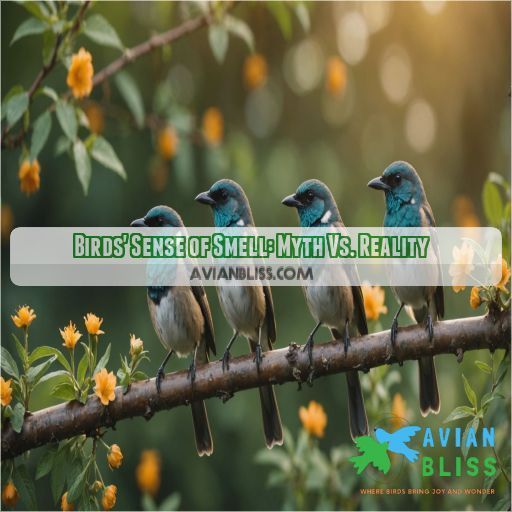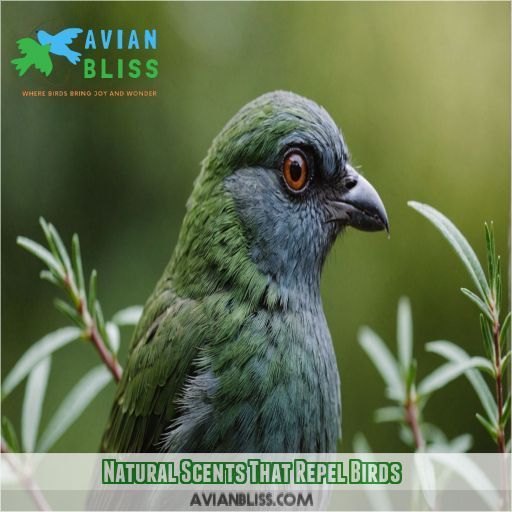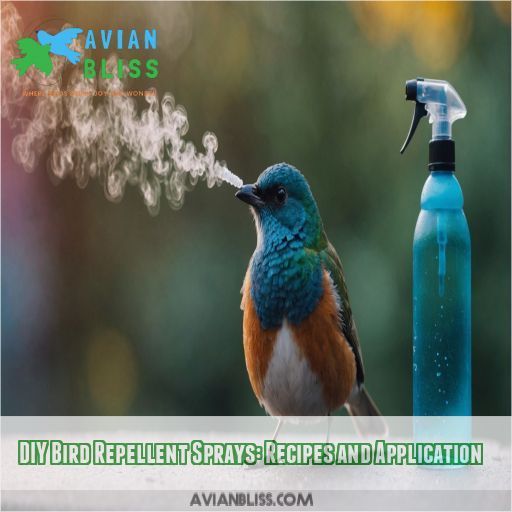This site is supported by our readers. We may earn a commission, at no cost to you, if you purchase through links.

Well, it turns out our feathered friends have a sensitive nose, and certain scents can send them flying (pun intended!).
Citrus fruits like lemon, orange, and lime are major turn-offs, as are spicy odors like chili and cayenne pepper.
Pungent herbs like peppermint, eucalyptus, and lavender also make the list, along with strong-smelling veggies like garlic and onion.
And, surprisingly, vinegar is a major bird-repellent too!
Want to learn how to harness these scents to keep those unwanted visitors at bay?
Table Of Contents
- Key Takeaways
- Birds’ Sense of Smell: Myth Vs. Reality
- Natural Scents That Repel Birds
- Chemical Bird Repellents: Effectiveness and Safety
- DIY Bird Repellent Sprays: Recipes and Application
- Comparing Scent-Based Deterrents With Other Methods
- Implementing a Comprehensive Bird Control Strategy
- Frequently Asked Questions (FAQs)
- Is there a scent that keeps birds away?
- What is a homemade remedy to keep birds away?
- Do birds hate the smell of vinegar?
- What is the best bird deterrent?
- Can smells be used to deter birds from gardens?
- Are bird-repelling scents safe for pets and children?
- How long do bird-repelling scents typically remain effective?
- Can bird-repelling scents be used in confined spaces?
- Are there scents that repel specific bird species only?
- Conclusion
Key Takeaways
- You’ll want to get familiar with citrus-based repellents, which can be a game-changer for keeping birds at bay – and it’s surprisingly easy to make your own using lemon, orange, or lime peels.
- Spicy odors like chili and cayenne pepper are major turn-offs for birds, and you can harness their power by mixing them with water to create a potent spray that will keep those feathered pests flying.
- Pungent herbs like peppermint, eucalyptus, and lavender can also help repel birds, and you can use their essential oils to create a refreshing yet effective bird-deterrent spray that is safe for humans and pets.
- Vinegar is another bird-repelling superstar, and you can use it to create a simple yet effective deterrent solution by mixing it with water – just be sure to reapply regularly, as its potency can fade quickly.
Birds’ Sense of Smell: Myth Vs. Reality
You’re about to discover the surprising truth about birds’ sense of smell – and how you can use it to keep those feathered pests at bay. As it turns out, birds do have a sense of smell, and certain scents can repel them, which is great news for anyone tired of cleaning up after these unwanted visitors.
Olfactory Abilities in Different Bird Species
You might be surprised to learn that birds have a decent sense of smell. Research shows that different bird species have varying levels of olfactory abilities. While they can’t rival bloodhounds, some birds can detect specific scents to find food or navigate. Let’s break it down:
- Homing pigeons have a highly developed sense of smell to find their way back home.
- Seabirds use their sense of smell to locate fish and krill in the ocean.
- Some songbirds can detect the scent of predators and alert their flock.
- Birds of prey, like hawks and eagles, have a relatively poor sense of smell, relying on vision instead.
- Parrots have a unique olfactory system, with some species able to detect the scent of certain fruits and vegetation.
Role of Smell in Bird Behavior
You’re now aware that birds do have a sense of smell, but how does it impact their behavior? Smell plays a vital role in mating, food detection, and even warning calls. Here’s a breakdown of the role of smell in bird behavior:
| Smell Function | Description | Example |
|---|---|---|
| Mating | Attracts mates, signals reproductive readiness | Male birds’ scent markings attract females |
| Food Detection | Locates food sources, detects predators | Seabirds smell krill-eating phytoplankton |
| Warning Calls | Alerts flock to potential threats | Birds sound alarm calls when detecting predators’ scents |
This complex olfactory system helps birds navigate their environment.
Comparison With Other Animals’ Sense of Smell
You’re probably wondering how birds’ sense of smell stacks up against other animals. Here’s a quick comparison:
- Mammals: Generally have a stronger sense of smell, with some exceptions (looking at you, dolphins!).
- Sharks: Infamous for their ability to sniff out blood, but did you know some birds can rival their smell skills?
- Insects: Can detect scents, but their olfactory system is way different from ours (or birds’, for that matter).
- Fish: Have an impressive sense of smell, but it’s limited to waterborne scents (obviously!).
Let’s get back to those feathered friends of ours!
Natural Scents That Repel Birds
You’re about to discover the secret scents that’ll keep those feathered pests at bay. From citrusy freshness to pungent herbs, we’ll explore the natural scents that birds hate, helping you win the battle against unwanted avian visitors.
Citrus-based Repellents (lemon, Orange, Lime)
You’re looking for a natural way to keep those feathered pests at bay. Citrus-based repellents to the rescue! Lemon, orange, and lime peels can be used to create a bird-deterrent spray. The acidity and strong scent of citrus fruits make them unpleasant for birds. Simply boil the peels in water, let it cool, and spray away!
Spicy Odors (chili, Cayenne Pepper, Hot Sauce)
You’ve tried citrus, now let’s turn up the heat with spicy odors! Birds detest the intense smell of chili, cayenne pepper, and hot sauce. Here are three reasons why:
- Chili pepper potency: Chili peppers contain capsaicin, a natural deterrent that irritates birds’ sensitive noses.
- Odor strength comparison: Cayenne pepper is particularly effective, with a Scoville heat unit rating of 30,000-50,000.
- Cayenne pepper safety: Don’t worry, cayenne pepper is safe for humans and other animals in moderation.
Pungent Herb Scents (peppermint, Eucalyptus, Lavender)
You’re probably familiar with the invigorating zing of peppermint or the calming properties of lavender. But did you know these herbs can also help keep birds at bay? Peppermint, eucalyptus, and lavender oils can be used to create potent bird repellents. Simply mix with water and spray around problem areas to enjoy a bird-free zone.
Strong-smelling Vegetables (garlic, Onion)
You’re probably thinking, "Garlic and onions, really?" But yes, these strong-smelling veggies can repel birds! Garlic spray, in particular, has shown effectiveness in deterring birds from gardens and crops. Mix crushed garlic with water and spray it around your vegetable garden for a natural pesticide alternative. Onion repellent recipes are also available online for a DIY approach.
Vinegar and Its Effectiveness as a Bird Deterrent
You’ve probably heard that vinegar can repel birds, but does it really work? The answer is yes, to some extent.
Vinegar spray can be an effective deterrent, especially when combined with other natural scents.
However, its effectiveness varies depending on concentration levels and bird species. Some birds may not be bothered by vinegar at all, so you may need to experiment and find the right blend for your feathered pests.
Chemical Bird Repellents: Effectiveness and Safety
As you explore ways to repel birds, you’ll discover that chemical bird repellents can be a surprisingly effective solution, especially when you understand what smells birds hate. In this section, we’ll break down the properties, application methods, and safety considerations of Methyl Anthranilate (MA), a natural substance that’s proven to repel birds without harming humans or other animals.
Methyl Anthranilate (MA) and Its Properties
You’re about to meet Methyl Anthranilate (MA), the ultimate bird repellent.
This natural substance is found in concord grapes and has a unique chemical structure that irritates birds’ noses and throats.
With a concentration level of around 20-30%, MA effectively repels birds without harming humans or the environment.
Its mechanism is a game-changer for bird control, and we’re about to explore its many uses.
Commercial MA-based Bird Repellent Products
You’re considering commercial MA-based bird repellent products. Look for product safety features like non-toxic and biodegradable formulas. Bird-Out and other MA-based spray solutions are popular choices. Bird repellent granules are also effective. Always check commercial application rates and follow local bird control regulations. See that the product is safe for people, pets, and the environment.
Application Methods and Recommended Usage
Now that you’ve got your MA-based bird repellent, let’s talk application methods. Here are some techniques to try:
- Spray Techniques: target specific areas where birds roost or feed
- Gel Applications: use on ledges, beams, or other narrow surfaces
- Granule Distribution: spread around plants or areas you want to protect
- Ultrasonic Placement: position near bird hotspots
- Aerial Spraying: ideal for large outdoor areas
Safety Considerations for Humans and Other Animals
When using chemical bird repellents, it’s vital to think about safety precautions for humans and animals. You want to guarantee your pets and family members aren’t inadvertently harmed.
| Safety Considerations | Precautions |
|---|---|
| Pet Safety | Keep pets away from treated areas until dry |
| Human Health | Wear gloves and masks when applying repellents |
| Animal Friendliness | Choose non-toxic, animal-friendly repellents |
| Non-Toxic Deterrents | Opt for natural deterrents like citrus or peppermint |
Environmental Impact of Chemical Bird Repellents
When using chemical bird repellents, you’ll want to think about their environmental impact. Methyl anthranilate, for instance, is generally safe, but excessive use can lead to soil and water contamination. Chemical accumulation can also harm wildlife, disrupting ecosystems. Be mindful of bird repellent toxicity and follow instructions to minimize risks to the environment and other animals.
DIY Bird Repellent Sprays: Recipes and Application
You’re ready to shake off those feathered pests using DIY bird repellent sprays, but first, you need to know the recipes and how to apply them effectively. Let’s get started with some potent concoctions that’ll make birds think twice before landing on your property, from citrus-based sprays to spicy mixtures and everything in between.
Citrus-based Homemade Repellent Spray
To create a citrus-based homemade repellent spray, mix equal parts lemon juice and water in a spray bottle. You can also add a few strips of orange peel for extra potency. This DIY spray is safe for humans and pets, but irritates birds’ sensitive noses. Shake well before use and reapply every few days for best results.
Peppermint and Citronella Mixture
Let’s mix things up with an invigorating DIY bird repellent! Combine peppermint and citronella oils to create a potent scent that birds can’t stand. Here’s what you’ll need:
- 10 drops of peppermint oil
- 10 drops of citronella oil
- 2 cups of water
- 1 tablespoon of mild dish soap
- A spray bottle to mix it all up
Give it a try and watch those feathered pests fly away!
Garlic and Chili Pepper Concoction
Here’s your DIY garlic and chili pepper concoction: mix 3 cloves of minced garlic, 1 teaspoon of chili pepper flakes, and 1 cup of water. Spray it around bird-infested areas, but beware – it’s potent! This spicy combo can irritate birds’ sensitive noses, keeping them at bay. Just remember to reapply regularly for maximum effectiveness.
Vinegar-based Repellent Solutions
Vinegar can be an effective DIY bird deterrent.
A vinegar-based repellent solution can be made by mixing 1 part white vinegar with 2 parts water.
Studies show that birds detest the strong acidity of vinegar.
This solution is safe for humans and pets.
Be sure to reapply the vinegar solution often, as the smell dissipates quickly.
Essential Oil Blends for Bird Deterrence
For DIY bird repellent sprays, essential oil blends can be a game-changer. Here are some bird-safe options:
- Peppermint and lemongrass oil blend: mix 10 drops of each with water and spray around the area.
- Lavender and tea tree oil blend: combine 5 drops of each with water for a calming yet effective repellent.
- Geranium and citronella oil blend: blend 10 drops of each for a potent bird-deterrent solution.
Comparing Scent-Based Deterrents With Other Methods
As you explore ways to keep birds at bay, you might wonder how scent-based deterrents stack up against other methods. Let’s compare the effectiveness of scents that repel birds with visual deterrents, physical barriers, sonic repellents, taste aversion techniques, and habitat modification strategies to help you choose the best approach for your feathered pest problem.
Visual Deterrents (reflective Tape, Predator Decoys)
Now that you’ve tried DIY bird repellent sprays, let’s explore visual deterrents. You can use reflective tape or predator decoys to scare birds away. Types of decoys include owl, snake, and hawk models. Place them strategically, like near food sources or nesting areas. While cost-effective, birds may adapt to these visuals over time, reducing their effectiveness.
Physical Barriers (netting, Spikes)
When you’re trying to keep birds away, physical barriers can be a big help.
Netting is a useful option, but getting it installed right is key. Choosing the right type of netting is also important, as it needs to be strong enough to keep birds away.
If you want to do it yourself, try using plastic or metal mesh to make a barrier. This can be an effective way to keep birds away without hiring a professional.
Watch how birds act around the barriers to adjust your plan. This will help you identify any weaknesses in your barrier and make necessary adjustments.
Sonic and Ultrasonic Repellents
Now that we’ve explored physical barriers, let’s talk about sonic and ultrasonic repellents. These devices emit frequencies undetectable to humans but unpleasant for birds. When placing devices, consider the area you want to cover and the bird species you’re targeting. Look for devices with adjustable frequency ranges (15-25 kHz) and follow manufacturer guidelines for effective placement and maintenance.
Taste Aversion Techniques
Now that we’ve explored sonic repellents, let’s talk taste aversion techniques. Imagine serving birds a meal they’ll never forget – in a bad way! Bird repellent granules containing non-toxic, unpleasant-tasting substances can deter birds. Chemical aversion agents like methyl anthranilate can be effective, but always opt for non-toxic bird repellents to guarantee safety.
Habitat Modification Strategies
Now that we’ve covered taste aversion techniques, let’s explore habitat modification strategies to keep those feathered pests at bay. By altering their environment, you can discourage birds from roosting and foraging. Consider these tweaks:
- Create a brush pile to attract beneficial wildlife and distract birds from your garden
- Retain snags to provide alternative roosting sites
- Plant native vegetation to shift the local food source away from your property
Implementing a Comprehensive Bird Control Strategy
You’re ready to take bird control to the next level by implementing a multi-faceted strategy that combines the power of scent-based deterrents with other effective methods. By identifying problem areas and bird species, combining multiple repellent methods, and maintaining a clean and sanitized environment, you’ll be well on your way to keeping those feathered pests at bay.
Identifying Problem Areas and Bird Species
Now that you’ve compared scent-based deterrents with other methods, it’s time to get up close and personal with your feathered friends. Identify problem areas by analyzing bird habitats, species distribution, and watching locations. Observe avian behavior patterns to determine their favorite hangouts. Look for nesting sites, droppings, and other signs of bird activity to pinpoint areas that need attention.
Combining Multiple Repellent Methods
Now that you’ve identified the problem areas and bird species, it’s time to combine multiple repellent methods for maximum efficacy. Think of it as a "one-two punch" – using a mix of visual, auditory, and scent-based deterrents to keep birds on their toes. Rotate methods seasonally to keep birds from adapting, and integrate physical barriers for a foolproof strategy.
Proper Cleaning and Sanitation Practices
Maintaining a clean facility is vital for keeping birds at bay. You see, birds are drawn to their own droppings and nesting evidence, so removing these attractants is a priority. Here are three must-do’s for a bird-free zone:
- Remove bird droppings: Wear gloves and a mask to avoid exposure to diseases.
- Disinfect all surfaces: Use a solution that’s safe for your equipment and the environment.
- Sanitize equipment regularly: This includes nets, cages, and any other gear that comes into contact with birds.
Regular Maintenance and Reapplication of Repellents
To keep those feathered pests at bay, you’ll need to stay on top of repellent maintenance. Set a reminder to reapply repellents every 2-4 weeks, depending on the product’s shelf life and weather conditions. Don’t forget to rotate your repellents to avoid bird habituation. Here’s a handy schedule to keep you on track:
| Repellent Type | Shelf Life | Reapplication Frequency |
|---|---|---|
| Methyl Anthranilate | 2-3 weeks | Every 2 weeks |
| Citrus-based | 1-2 weeks | Every 1 week |
| Spicy Odors | 2-4 weeks | Every 3 weeks |
| Vinegar-based | 1-2 weeks | Every 1 week |
| Essential Oils | 1-3 weeks | Every 2 weeks |
Monitoring Effectiveness and Adjusting Tactics
Now that you’ve reapplied your repellents, it’s time to gauge their effectiveness. Monitor bird behavior, taking note of any changes in their visits or roosting patterns. Analyze data to determine the success of your methods. Here are some key things to keep in mind:
-
- Repellent impact: Are the scents you’re using truly deterring birds?
-
- Environmental factors: Are weather conditions or seasonal changes affecting bird behavior?
-
- Bird behavior: Are the birds adapting to your repellents or finding ways to circumvent them?
-
- Success metrics: What criteria will you use to measure the success of your bird control strategy?
Frequently Asked Questions (FAQs)
Is there a scent that keeps birds away?
You’re looking for a scent to keep birds away, but first, let’s talk about what attracts them – food, droppings, and nesting evidence. Now, certain smells like peppermint, garlic, and citrus can repel birds .
What is a homemade remedy to keep birds away?
You can create a homemade bird repellent using garlic, peppermint, vinegar, chili, lemon, citronella, cinnamon, cayenne pepper, or mothballs .
Do birds hate the smell of vinegar?
Ahoy, matey! You’re wondering if birds detest the smell of vinegar, eh? Indeed, birds tend to dislike the pungent aroma of vinegar, but its effectiveness as a repellent is limited and requires frequent reapplication, savvy?
What is the best bird deterrent?
You’re looking for the best bird deterrent. Consider using methyl anthranilate (MA), a natural substance found in concord grapes that repels birds . Combine MA with cleaning up bird droppings and nests, and removing food sources for effective bird control.
Can smells be used to deter birds from gardens?
Did you know 80% of bird infestations can be solved by removing attractants? To safeguard your garden, use smells like methyl anthranilate, found in concord grapes, to repel birds. It’s safe for humans and animals, but birds can’t stand it!
Are bird-repelling scents safe for pets and children?
When choosing bird-repelling scents, make sure they’re safe for pets and children. Opt for non-toxic, natural ingredients like citronella, lemongrass, or peppermint. Always follow product instructions and consult with a veterinarian if you’re unsure.
How long do bird-repelling scents typically remain effective?
Like a freshly brewed cup of coffee, bird-repelling scents‘ effectiveness can fade quickly, typically lasting anywhere from a few days to a week, depending on the type and concentration of the scent, as well as environmental factors.
Can bird-repelling scents be used in confined spaces?
When using bird-repelling scents in confined spaces, you’ll want to exercise caution to avoid overwhelming yourself and others . Choose mild, natural options like peppermint or lemon, and start with small amounts to test the air quality .
Are there scents that repel specific bird species only?
You’re wondering if certain scents can repel specific bird species only. Well, research suggests that while some scents, like methyl anthranilate, can repel a broad range of birds, others may be more species-specific, like citronella for seagulls.
Conclusion
Now that you’ve got the inside scoop on what smells birds hate, it’s time to "scent" them packing!
By harnessing the power of citrus, spices, herbs, and vinegar, you can create a bird-repellent arsenal that’ll keep those feathered pests at bay.






0 Comments